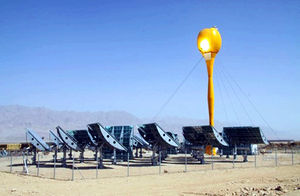Knowledge fuels change
For over a decade, Energypedia has shared free, reliable energy expertise with the world.
We’re now facing a serious funding gap.
Help keep this platform alive — your donation, big or small, truly matters!
Thank you for your support
Concentrating Solar Power (CSP) - Basics and Introduction
Basics and Technology of CSP
Go back to the < CSP Overview. |
General
CSP Systems are replacing fossil fuels with CO2-emission free energy and therefore reduce the overall greenhouse gas emissions. According to Greenpeace the energy pay back time of an CSP plant can amount to just 5 months depending on its configuration and size.[1] CSP Plants can remain in operation for almost 40 years and thus demonstrate its durability and reliability. Generation costs are currently at reasonable levels and still dropping
Technologies
Please follow this link to watch a short introduction on Concentrating Solar Power:
CSP technology, being quite different from the more popular photovoltaic equpiment, concentrates sunlight to effectively create heat to raise steam. However, there are different types of technology working under title of CSP. In the following chapters, the idea of the “parabolic trough”, the “power tower”, the “Fresnel mirror system” (or simply “linear Fresnel”) and the “dish” will be presented.
Parabolic Trough
Power Tower
The power tower really lives up to its promise. Compared to other CSP technologies, it can create the highest degree of temperature. Surrounded by mirrors reflecting light onto an elevated and centered tower, the power tower generates heat of about 1,000 C°.[2] By transferring the reflected concentrated solar radiation to a fluid, steam is being produced that expands on a turbine in order generate the intended electricity.[3]
Linear Fresnel
Dish / Engine
Storage Techologies
CSP Today
List of CSP projects
Click here to view, browse and add project information about CSP projects on Energypedia: CSP Projects.
See List of solar thermal power stations and List of concentrating solar thermal power companies (Wikipedia)
References




















